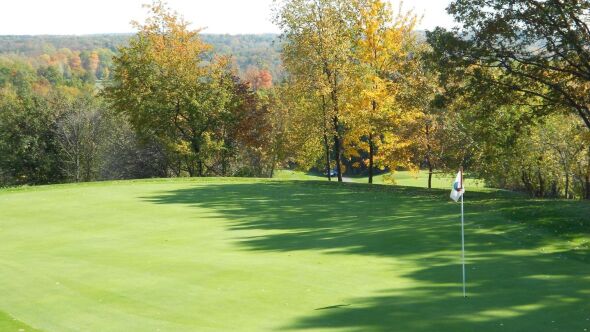The word "masterpiece" gets thrown around too liberally in all realms of art. At least in golf architecture, the term should be reserved for courses that have 18 holes that extract the full range of necessary golf skills from those who cross the threshold of its first tee. Power, precision, mental fortitude, shot-shaping, short-game wizardry, steely putting - not a single core competency is left untested. On top of the technical aspects, a masterpiece course must be appealing to look at, challenging without brutalizing the middling golfer while seeming unconquerable by the very best. There must also be the sense that the whole is greater than the sum of its constituent par 3s, 4s and 5s.
Pinehurst No. 2 is a masterpiece of American golf.
Originally laid out in 1907, No. 2 benefited from consistent, close scrutiny from creator Donald Ross for four further decades, as the Scottish master of Golden Age design would live in a house, Dornoch Cottage, alongside the course's third hole from 1925, up through the 1935 conversion of No. 2's greens from oiled sand to grass until his passing in 1948. Over those years, he oversaw various subtle and overt tweaks to the playing characteristics of the course that redound to the present thanks to a long legacy of stewardship punctuated by Bill Coore and Ben Crenshaw's sensitive 2010 restoration effort that restored the greens to their original dimensions and the unique North Carolina Sandhills character to the course.

In just a quarter century, Pinehurst No. 2 has vaulted in stature from a respected genteel resort course to one of the best-regarded championship tests we have. It didn't host its first U.S. Open until 1999, but Payne Stewart's thrilling victory on the final hole over Phil Mickelson was instantly one of the greatest major championship moments ever. Wins by Michael Campbell in 2005 and Martin Kaymer in 2014 have kept No. 2 top-of-mind to golf fans and the United Stated Golf Association, which, in 2020, announced it would become one of the organization's "anchor sites," conferring the 2029, 2037 and 2043 U.S. Opens on it, as well as a slew of other championships. This long-term commitment that includes the opening of a southern USGA headquarters, plus the relocation of the World Golf Hall of Fame to a site a few hundred yards from the first tee, has only added to the region's golf aura. It is America's spiritual counterpart to Scotland's St. Andrews.
Pinehurst No. 2 sits apart from many other championship courses because it is accessible to the public. Pinehurst Resort guests may play it for a fee and walk its graceful pine-lined hallways with members of a first-rate caddie corps that includes gentlemen who have looped there for half a century and know the greens better than you know your own children.
The golf course unfolds brilliantly, with some of the shortest green-to-tee walks anywhere for golfers who play the middle tees. The property is not so much rollicking as lilting, with relatively few shots that gain or lose more than 10 feet vertically. Some fairways are rather flat, while others tilt and camber just enough to amp up the challenge of hitting the greens.
And what greens they are. Described variously as turtle-backed, upside-down cereal bowls and with other, unprintable adjectives, they average just under 6,000 square feet but play much smaller because of their down-turned edges, which shuttle golf balls into low-slung short-grass areas, deep bunkers and even the native pine straw and sandy roughs that give holes definition while testing players who stray with a variety of lies (some of them quite good!), rather than lush and one-dimensional Bermuda roughs. Reaching the center of greens usually means reasonable putts, though reading those putts can be maddening. The vast majority of players will not lose a golf ball all week, but may run up scary scores nevertheless, especially if their ball-striking deserts them.
No. 2's values do not favor any one type of player. The course is long, but with the native roughs denser than they were last time out, hitting fairways will likely be more important than it was in 2014. Look for the relentless approach-shot demands to thin out the field as they did when Martin Kaymer cruised to his 8-shot win a decade ago. If not another blowout, a final-round tussle between two, three or four players seems more likely than a donnybrook where half a dozen or more golfers have a chance to win.
What the course may lack in external scenery, it more than makes up in all-out golf intrigue. Savvy golfers will be glued to TV coverage all week. Here is what you should know about each hole at Pinehurst No. 2:
Pinehurst No. 2
Par 70, 7,543 yards
Hole 1 - Par 4, 398 yards

Rather than pedestrian warmups, the best opening holes tend to be mission statements for their golf courses. This one is exactly that, introducing the golfer immediately to the scenery and values that can be expected over the coming four hours. The elevated green drops off on all sides, so a loose first approach - likely with a short iron - will immediately show just what it means to miss a green at No. 2.
Hole 2 - Par 4, 500 yards

Dozens of U.S. Open rounds will start 3-5, as the relatively gettable first is followed by a long, demanding dogleg right whose fairway wants to funnel tee shots to the left. The green is larger than it looks from the landing area but there's still plenty of peril as it drops away in the back.
Hole 3 - Par 4, 387 yards

The give-and-take continues with the friendliest par 4 on the course, where a good tee shot will leave a wedge at most. The back-to-front pitch of the smallish green will make spin control tricky, but there will be scores of birdies here, and maybe even the odd eagle if the USGA moves the tee markers up one of the days.
Hole 4 - Par 4, 528 yards

The first three holes drift upward ever so slightly, so walking off the back of the third green to see the fairway some thirty feet below, crawling back uphill, may take some players by surprise. This hole used to be a gimme par 5 but traded par designations with the 5th before the 2014 U.S. Open. Players will want to send driver here, knowing that even if they miss the fairway, the green is on the milder side by No. 2's standards, less turtlebacked than tilted from back to front.
Hole 5 - Par 5, 588 yards

It has played as a menacing par 4 in the past, but with the 4th hole being knocked down to a par 4, number 5 gets to be one of the greatest par 5s in championship golf. The fairway is generous but its leftward tilt pulls tee shots into dicey spots, while the green complex is the best of Pinehurst's near-incomparable set of 18. The oval green plays a fraction of its size, with the left side dropping off into some of the roughest territory on the course. Bailing out right is no picnic either, because an overplayed pitch will end up in that left-side cellar, too. Anyone who hits and holds this green in two shots deserves a medal. Just a terrific golf hole that brings all of No. 2's greatest elements together.
Hole 6 - Par 3, 216 yards

The first par 3 on the golf course is the longest and potentially toughest, especially if the hole location wanders back and to the left, placing it close to a deep, yawning trap. More bunkers along the right side will keep players honest, as will a false front. Mid- and long-iron flushers will prosper at No. 2 because making low-stress pars on holes like this will help them retain energy and momentum amid the drumbeat of challenging shots to come.
Hole 7 - Par 4, 426 yards

The sharpness of this dogleg right and the flatness of the hole makes the tee shot tricky because the native grasses obscure the fairway from view. The hole therefore tests players' preparation skills and their ability to trust their chosen line. The green is not particularly nasty, but no one will want to approach it from the rough or any of seven fairway bunkers.
U.S. OPEN SETUP/RULES NOTE: Any sandy area not fully enclosed by grass at Pinehurst No. 2 will be part of the general area, and therefore players will be able to ground their club in the sand and take practice swings.
Hole 8 - Par 4, 492 yards

One of two par 5s for members and guests that plays as a par 4 in big championships, this is the hole that caused John Daly to play polo after multiple failed attempts to get his ball to safety on the green from the collection areas surrounding it in 1999. Because it's built for a short iron or wedge, players who hit middle and long irons here will be sweating even harder than usual in the mid-June heat. The only viable miss is short; pin-high left or right is nightmarish and long is utterly dead.
Hole 9 - Par 3, 184 yards

No. 2's prettiest set-piece plays gently downhill to a green that looks like it was meant to be there. The higher left side holds the least accessible hole locations, while the right-side ones are the most dangerous because any approach that wanders too far right will be sent into bunkers or towards the forward tee areas for the 10th hole.
Hole 10 - Par 5, 617 yards

The modern power game means that the longest hole on the golf course will be one of the easiest. Bombers will look to obliterate a tee shot and leave a chance to reach the relatively large and mild green in two. As at the 7th hole, players will be trying to peer over the native grasses in order to envision the spot on or around the green that they need to get to in order to make an easy birdie. Given the difficulty of the rest of the course, it's hard to imagine this week's champion making fewer than three birdies here over four rounds.
Hole 11 - Par 4, 478 yards

The meat of the back nine - three long par 4s and a short one, all of them first-rate holes - begins here. The first of three consecutive greens where putting can be especially maddening greets those who can lace a tee shot up the right side of the fairway. The subtlety of the interior tilt will cause all sorts of misreads and doubt-ridden poor putts. Great green-reading players and caddies will separate themselves from the pack here.
Hole 12 - Par 4, 486 yards

A gentle downhill slope will make players want to swing hard, but placement is paramount here as the green is slightly offset to the fairway and ringed by bunkers. A slight indent along the left side of this green gives it a kidney-bean shape. This is the juncture where players will be starting to assemble their scores, and a birdie on 10 followed by pars on 11 and 12 will whisk contestants to the shortish next hole with plenty of momentum.
Hole 13 - Par 4, 381 yards

The second of No. 2's short par 4s features the only real architectural change made since the 2014 U.S. Open. This fairway has been slimmed down from 40 to 28 yards wide, with all of that extra fairway lopped off of the left. The uphill approach to a slick green could be the toughest wedge shot of the day. This will make a layup tee shot trickier and might even make some players consider punching a tee shot up towards the green. Like hole 3, this little beauty could be particularly exciting if the USGA gets saucy with tee placement one day.
Hole 14 - Par 4, 472 yards

Just as holes 4 and 5 occupy their own finger of the routing, 13 and 14 sit akimbo to the right of Maniac Hill, Pinehurst's main driving range (a tented village for the U.S. Open). This lengthy par 4 plays down the hill the previous one climbed, with a fairway bunker on the left intruding on the appealingly straightaway look from tee to green. The putting surface sets up similarly; two straight shots here will leave plenty of holeable birdie attempts.
Hole 15 - Par 3, 199 yards

Pinehurst No. 2's par threes come late in each nine, but they're worth the wait. This one is particularly intimidating, showing off a seemingly huge false front that wants to slough any short approach off to the right. The interior of the green actually runs away to the back-right, complicating downwind approaches, especially as the greens firm up.
Hole 16 - Par 4, 536 yards

The second par-5-turned-par-4 is one of championship golf's longest two-shot holes, meandering left off the tee and funneling into a deliciously situated green - the smallest on the course. A wicked false front and significant back-to-front tilt will vex even the longest hitters here.
Hole 17 - Par 3, 207 yards

Another beautifully sited green harangues players with its front-left-to-back-right angling and two menacing bunkers short left and right. It's not a particularly long hole but any significant breezes are likely to swirl around the longleaf pines and bleachers, complicating club selection.
Hole 18 - Par 4, 448 yards

It's not championship golf's toughest finisher, but it's one of the most iconic, thanks to Payne Stewart's legendary walk-off putt in 1999. The hole tacks uphill and to the right, with right-side rough drawing the eye and golf ball more often than most players would prefer. In addition to the typical perimeter falloffs, the green has a two-tiered feel, playing even smaller than it appears. The combination of grandstands and low-slung clubhouse just behind the green - plus Payne's statue looking on - gives this graceful finisher the sort of gravitas enjoyed by most Open Championship 18th holes. It's a worthy finale for America's premier golf tournament.
Sign up for our newsletter
No one knows golf courses, travel, equipment and instruction like GolfPass. We would love to send you money-saving golf travel advice, equipment reviews and world-class instruction tips every Tuesday and Friday, for free.



















Coming from caddying at Pinehurst for 5 years, saying “mild greens” makes me wonder if Tim ever played here. The Par 3 6th playing 240 yards was one of the hardest holes on the course and averages, 3.4, so I don’t know about any stress free pars there. The front right pin will be nasty and we’ll see a lot of putts rolling off the front.
At 600+ yard par 5, I don’t know if it’s an “easy birdie.”
Hi Tyler, I think all of your criticisms are due to misconstruing what was written. He never said the sixth was "stress free". And the mild greens comment on the 600-yard 10th was noting that the green was mild compared to others at Pinehurst No. 2. We all look forward to seeing how the modern game fares against such a historic course.